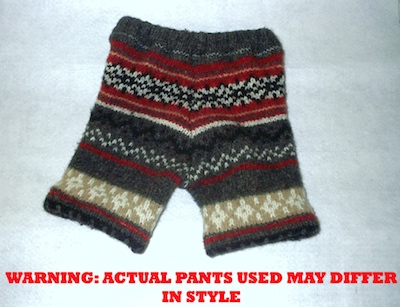Keeping up to date in chronic back pain research is a busy process and yet it is rare that a new paper really catches the eye. A while back a trial of methylene blue injections appeared to demonstrate surprisingly impressive results. I blogged on it (here) and mused on how results that good really need to be independently replicated before we can confidently accept them. But today a trial of a new therapeutic approach was dredged up in my search alerts. It is clearly novel and ground breaking. It is…. wait for it….woollen knickers.
In this RCT 48 CLBP patients were randomised to wear either woollen knickers (technically 75% merinos wool and 25% acrylic) or “placebo” knickers. Really. Not a “no treatment” or “going commando” control for this study, but 100% cotton underkeks. Now a placebo condition ideally has to have the same credibility as the active treatment. The question is, which do you think would be better for your back pain? I am undecided. What I am decided on is that the concept of “placebo underwear” for some reason gives me great joy. I must try to grow up.
Anyway participants had to wear these particular undercrackers for a 2 month experimental period. The study took place in Turkey in spring. I would imagine it might get quite warm? Given that, one question that bothers me is “how many pairs were they given?”. I am hoping numerous. There is no mention of adverse events in the report but I have concerns that the risk of sweaty gusset syndrome may well be higher with the active treatment.
But what of the results? Well brace yourselves and put this in the context that all treatments struggle to achieve meaningful effect sizes in CLBP. I have extracted the data from the report and made some graphs. The labelling is mine (apologies in advance).
First pain (0-100 visual analogue scale):
![]() This represents a 90% (95%CI to 80-99%) reduction in pain from baseline. Read that again.
This represents a 90% (95%CI to 80-99%) reduction in pain from baseline. Read that again.
Now disability (Oswestry Disability Index)
That is a 64% (95% CI 50 to 77%) improvement in disability.
Hold the phones people! Chronic back pain virtually cured? All from wearing woolly panties? How could this work? What is the “active ingredient” of robust , thick (and potentially itchy) hosiery? The authors suggest that it is down to the role that being cold has to play in chronic back pain and the heat trapping qualities of woollen underwear. I’m going to come right out and say I don’t buy into this hypothesis that the problem of CLBP is largely temperature related. And because I have difficulty believing the proposed mechanism of action I have difficulty being confident in the results.
There are some methodological quibbles with the trial too. The method of randomisation and allocation concealment is not clear, there is no information on dropouts, it isn’t clear if the process of gathering the primary outcomes was properly blinded (easy to do- just get them to keep their trousers on!). But even if these issues were resolved I would still be troubled by scepticism. Any number of complex, multimodal and arguably (?) more plausible therapies have failed to produce astounding effects like these. It is simply hard to believe that something as simple as woolly grundies could or would. It is a rare case where the very size of the effect makes it harder to believe. Reassuringly though there does not appear to have been a sinister corporate funding influence from Big Pants-a (sorry).
Marcello Truzzi once said said “extraordinary claims require extraordinary proof”. I think these results are extraordinary. I would need to see bigger better trials (but won’t hold my breath for the first international multicentre mega-trial of woollen y-fronts for CLBP). Maybe we need some other observational studies to test the underlying hypothesis. Would we predict a higher incidence of CLBP in thong wearers (NB: not the Aussie meaning of thong) or those with a predilection for sporting insubstantial lacy numbers? Suggestions for future tests are welcome!
About Neil
 As well as writing for Body in Mind, Neil O’Connell is a researcher in the Centre for Research in Rehabilitation, Brunel University, West London, UK. He divides his time between research and training new physiotherapists and previously worked extensively as a musculoskeletal physiotherapist. He also tweets! @NeilOConnell
As well as writing for Body in Mind, Neil O’Connell is a researcher in the Centre for Research in Rehabilitation, Brunel University, West London, UK. He divides his time between research and training new physiotherapists and previously worked extensively as a musculoskeletal physiotherapist. He also tweets! @NeilOConnell
He is currently fighting his way through a PhD investigating chronic low back pain and cortically directed treatment approaches. He is particularly interested in low back pain, pain generally and the rigorous testing of treatments. Link to Neil’s published research here. Downloadable PDFs here.
References
Kiyak E (2012). The impact of wool in the patients with chronic non-specific low back pain. Collegium antropologicum, 36 (2), 623-6 PMID: 22856254



